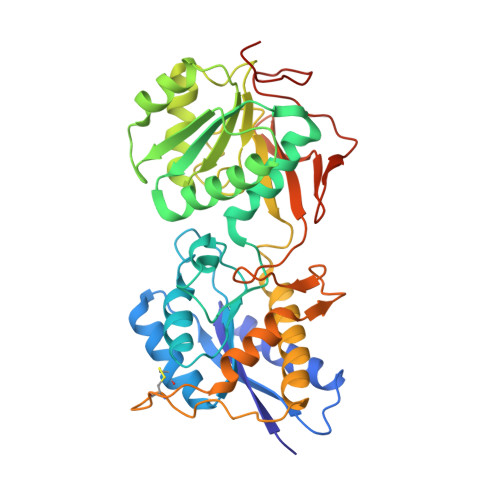Separation of Domain Contacts Is Required for Heterotetrameric Assembly of Functional NMDA Receptors.
Farina, A.N., Blain, K.Y., Maruo, T., Kwiatkowski, W., Choe, S., Nakagawa, T.(2011) J Neurosci 31: 3565-3579
- PubMed: 21389213
- DOI: https://doi.org/10.1523/JNEUROSCI.6041-10.2011
- Primary Citation of Related Structures:
3Q41 - PubMed Abstract:
The precise knowledge of the subunit assembly process of NMDA receptors (NMDA-Rs) is essential to understand the receptor architecture and underlying mechanism of channel function. Because NMDA-Rs are obligatory heterotetramers requiring the GluN1 subunit, it is critical to investigate how GluN1 and GluN2 type subunits coassemble into tetramers. By combining approaches in cell biology, biochemistry, single particle electron microscopy, and x-ray crystallography, we report the mechanisms and phenotypes of mutant GluN1 subunits that are defective in receptor maturation. The T110A mutation in the N-terminal domain (NTD) of the GluN1 promotes heterodimerization between the NTDs of GluN1 and GluN2, whereas the Y109C mutation in the adjacent residue stabilizes the homodimer of the NTD of GluN1. The crystal structure of the NTD of GluN1 revealed the mechanism underlying the biochemical properties of these mutants. Effects of these mutations on the maturation of heteromeric NMDA-Rs were investigated using a receptor trafficking assay. Our results suggest that the NTDs of the GluN1 subunit initially form homodimers and the subsequent dimer dissociation is critical for forming heterotetrameric NMDA-Rs containing GluN2 subunits, defining a molecular determinant for receptor assembly. The domain arrangement of the dimeric NTD of GluN1 is unique among the ionotropic glutamate receptors and predicts that the structure and mechanism around the NTDs of NMDA-Rs are different from those of the homologous AMPA and kainate receptors.
Organizational Affiliation:
Department of Chemistry and Biochemistry, University of California, San Diego, La Jolla, California 92093, USA.
















